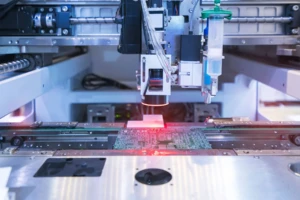The Future of Automation: Printed Electronics & Printed Sensors
“Meet George Jetson.” “His boy Elroy” “Daughter Judy” “Jane his Wife” “Their dog Astro”

Did we just catch you singing the theme song to the hit cartoon, “The Jetsons” of the 60s and 80’s era? If so, you recall watching (probably with a curious mind) the futuristic cartoon set in the year 2062. Did you ever wonder if there could actually be a world with video phones, automated appliances, robots or flying cars? Could your house or workplace actually communicate with you intelligently?
Thanks to an emergent field of printed electronics, it is quite possible.
Printed electronics (PE) is the process of printing electrically functional inks or other materials on a substrate using industrial printing processes. PE is gaining popularity with OEM’s across various industries, as the demand of smaller, less expensive, connected tech devices increases. Printed electronics is considered to be an alternative to the traditional Printed Circuit Boards (PCB). Simply put, PE is a light-weight, flexible and cost effective way to embed intelligence into so many products and objects around us. IDTechEx Research finds that the total market for printed, flexible and organic electronics will grow from $41.2 Billion in 2020 to $74 billion in 2030.
Some of the common applications for printed electronics
- Personal Health/Biomedical
- Automotive and Mobility
- Smart Building
- Printing and Packaging
DuraTech’s role in the printed electronics market
Printed electronics opens a host of design opportunities, and that is where we come in. We have a passion for innovation and are never afraid of taking on challenges. Our Technology and Project Development Team, along with our ink and material suppliers, continuously explore and develop processes to print electronic components for a variety of products within the industries we serve such as, medical, industrial, appliance, electronics and automotive.
With our development in printed electronics, we are also paving the way for printed sensors. Printed sensors are evolving at a faster rate than ever. Printed sensors can monitor temperature and moisture, as well as pressure and motion. Unlike conventional sensors, printed sensors can be thin and lightweight, cost effective and can be embedded within devices. According to Printed Electronics Now, flexible and printed sensors continue to find new applications and are playing an increasingly important role in printed electronics. IDTechEx even predicts the market for fully printed sensors will reach $7.6 billion by 2027.
What is contributing to this market growth? It all comes back to connectivity, or the ever growing demand for smartphones, devices, televisions and industrial electronics.
Similar to the cartoon home of the Jetsons, homeowners today expect smart-home technology, where they can communicate intelligently with things like appliances equipped with touchscreen displays and sensors or voice controlled lights and home entertainment. Because of that, more homes are becoming automated. Consumers are used to having smart technology at their fingertips, so why should their home be any different? According to the article, “Home Automation Will Increase in Popularity in the Next Decade” “Americans are remodeling their homes more often than ever before and smart-home upgrades are becoming a popular addition to these projects because they can save power, reduce utility costs and make homes more comfortable and convenient.”
Time Magazine says home automation is predicted to increase over the next decade, so manufacturers are putting their R&D and marketing budgets behind home-monitoring and security gadgets. Time Magazine also says, “Health applications will drive at least some of the smart-home growth over the next decade. Cameras and sensors embedded in refrigerators will suggest more nutritious alternatives if people are reaching for the sugary sodas a little too frequently. Similar technology in medicine cabinets will check if residents have taken their prescriptions.”

Aside from home automation, industrial automation is becoming more prevalent in manufacturing plants. The future of these plants cannot be envisioned without the idea of them being automated in some form. The Newsletter, Robotics and Automation News details how automation is disrupting manufacturing in 2020. They share that we are entering an era of smart factories and automated manufacturing, and companies are now implementing automation technologies and replacing old assembly lines.
In particular, sensors are helping industrial automation become greater. Sensors are critical to automating any machine or process. Depending on their configuration, these devices can help detect proximity, pressure, temperature, level, flow and more; which provides the following advantages:
- Improving productivity
- Reducing errors and waste
- Increase in safety
- Reliability
- Enhanced consistency of processes or product
Printed electronics technologies offer the capability to incorporate sensors into a manufacturing process using functional materials.
In a blog entitled, “Smart Sensors are Key to Industrial Automation” it writes that “Sensors and automation can help augment the entire industry and offset the growing labor shortage. As experienced workers reach retirement age, there aren’t enough skilled laborers entering the industry to complete the work. Transition to partial or full automation before these individuals retire can help keep the factories and plants running.” The blog continues to say that automated factories may help entice younger graduates to enter manufacturing as they have been raised in a world that embraces technology.
While some worry that automation will replace the human worker, Robotic and Automation News assures us that evidence points in a different direction. Their findings conclude that machines and humans can collaborate to increase innovation, productivity and efficiency.
Plant Automation Technology reports that “industrial automation market is expected to reach USD 153.83 billion by 2022, growing at a CAGR of 5.10% between 2017 and 2022. Moreover, usage of automation techniques is on the rise and is expected to continue rising for the foreseeable future.”
Printing and electronics are a great match for each other. Like DuraTech, they are driven by innovation. Both technologies work well together to achieve functionality and decorative appeal.
We really are not too far away from living and working like the Jetsons. Connectivity is the present, not just the future. If you are an OEM for the consumer automation field or industrial automation field and have a unique idea for printed electronics, including printed sensors, we want to explore with you. We know very well that with printed electronics comes challenges, but we have the knowledge, experience and a variety of ink suppliers who partner with us to help develop exciting and not to mention, futuristic products-just not flying cars yet!